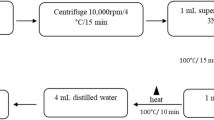Abstract
β-1,3-Glucan (curdlan) is a water-insoluble polysaccharide composed exclusively of β-1,3 linked glucose residues. Extracellular curdlan was mostly synthesized byAgrobacterium species andAlcaligenes faecalis under nitrogen-limiting conditions. In this study, we screened the microorganisms capable of producing extracellular curdlan from soil samples. For the first time, we reported Gram-positive bacteriumBacillus sp. SNC 107 capable of producing extracellular curdlan in appreciable amounts. The effect of different carbon sources on curdlan production was studied and found that the yield of curdlan was more when glucose was used as carbon source. It was also found that maximum production was achieved when the initial concentration of ammonium and phosphate in the medium was 0.5 and 1.9 g/L respectively. In this study the curdlan production was increased from 3 to 7 g/L in shake flask cultures.
Similar content being viewed by others
References
Harada, T., M. Masada, K. Fujimori, and I. Maeda (1996) Production of a firm, resilient gel-forming polysaccharide by a mutant ofAlcaligenes faecalis var. myxogenes 10c3.Agric. Biol. Chem. 30: 196–198.
Lawford, H., J. Keenan, K. Phillips, and W. Orts (1986) Influence of bioreactor design on the rate and amount of curdlan-type exopolysaccharide production byAlcaligenes faecalis.Biotechnol. Lett. 8: 145–150.
Lee, J. H., I. Y. Lee, M. K. Kim, and Y. H. Park (1999) Optimal pH control of batch processes for production of curdlan byAgrobacterium species.J. Ind. Microbiol. Biotechnol. 23: 143–148.
Harada, T., A. Misaki, and H. Saito (1968) Curdlan: a bacterial gel-forming β-1,3-glucan.Arch. Biochem. Biophys. 124: 292–298.
Masayuki, T. and N. Yukihiro (1990) Noodle made of rice powder and producing method thereof.Japanese Patent 02249466.
Spicer, E. J. E., E. I. Goldenthal, and T. Ikeda (1999) A toxicological assessment of curdlan.Food Chem. Toxicol. 37: 455–479.
Kanke, M., E. Tanabe, H. Katayama, Y. Koda, and H. Yoshitomi (1995) Application of curdlan to controlled drug delivery. III. Drug release from sustained release suppositoriesin vitro.Biol. Pharm. Bull. 18: 1154–1158.
Takeda-Hirokawa, N., L. P. Neoh, H. Akimoto, H. Kaneko, T. Hishikawa, I. Sekigawa, H. Hashimoto, S.-I. Hirose, T. Murakami, N. Yamamoto, T. Mimura, and Y. Kaneko (1997) Role of curdlan sulfate in the binding of HIV-1 gp120 to CD4 molecules and the production of gp120-mediated TNF-α.Microbiol. Immunol. 41: 741–745.
Kim, I. Y., K. E. Rye, W. A. Choi, Y. H. Rhee, and I. Y. Lee (2003) Enhanced production of β-1,3-D-glucan by a mutant strain ofAgrobacterium species.Biochem. Eng. J. 16: 163–168.
Miller, G. L. (1959) Use of dinitrosalicylic acid rengent for determination of reducing sugar.Anal. Chem. 31: 426–428.
Srienc, F., B. Arnold, and J. E. Bailey (1984) Characterization of intracellular accumulation of poly-β-hydroxybutyrate (PHB) in individual cells ofAlcaligenes eutrophus H16 by flow cytometry.Biotechnol. Bioeng. 26: 982–987.
Chen, Jr., P. S., T. Y. Toribara, and H. Warner (1956) Microdetermination of phosphorus.Anal. Biochem. 28: 1756–1758.
Naganishi, I., K. Kimura, S. Kusui, and E. Yamazaki (1974) Complex formation of gel-forming bacterial β-1,3-D-glucan (curdlan type polysaccharide) with dyes in aqueous solution.Carbohydr. Res. 32: 47–52.
Lee, I. Y., W. T. Seo, K. G. Kim, M. K. Kim, C. S. Park, and Y. H. Park (1997) Production of curdlan using sucrose or sugar cane molasses by two-step fed-batch cultivation ofAgrobacterium sp.J. Ind. Microbiol. Biotechnol. 18: 255–259.
Mimura, T. (1993) Biosynthesis of curdlan from culture media containing13C-labeled glucose as the carbon source.Carbohydr. Res. 240: 153–159.
Sutherland, I. W. (1977) Microbial exopolysaccharide synthesis, pp. 40–57. In: P. A. Sanford and A. Lakin (eds.).Extracellular Microbial Polysaccharides. American Chemical Society. Washington, DC, USA.
Kim, M. K., I. Y. Lee, J. H. Lee, K. T. Kim, Y. H. Rhee, and Y. H. Park (2000) Residual phosphate concentration under nitrogen-limiting conditions regulates curdlan production inAgrobacterium species.J. Ind. Microbiol. Biotechnol. 25: 180–183.
Farres, J., G. Caminal, and J. Lopez-Santin (1997) Influence of phosphate on rhamnose-containing exopolysaccharide rheology and production byKlebsiella 1–714.Appl. Microbiol. Biotechnol. 48: 522–527.
Author information
Authors and Affiliations
Corresponding author
Rights and permissions
About this article
Cite this article
Gummadi, S.N., Kumar, K. Production of extracellular water insoluble β-1,3-glucan (curdlan) fromBacillus sp. SNC07. Biotechnol. Bioprocess Eng. 10, 546–551 (2005). https://doi.org/10.1007/BF02932292
Received:
Accepted:
Issue Date:
DOI: https://doi.org/10.1007/BF02932292




